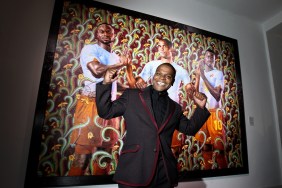Artwork: Kehinde Wiley, Sleep, 2008, oil on canvas, 132 x 300 in. (335.3 x 762 cm). Courtesy of Rubell Family Collection. © Kehinde Wiley.
The Rubell Family Collection (RFC), first established in 1964 by founders Donald and Mera Rubell, is now one of the largest, privately owned contemporary art collections in the world. Based in Miami, Florida, the RFC actively acquires, exhibits, and champions emerging artists working at the forefront of the art scene.
Also: Books | Glenn Ligon: A People on the Cover
In 2008, the RFC organized 30 Americans, an historic exhibition featuring the work of the leading African-American artists of the last three decades, including Jean-Michel Basquiat, Nice Cave, David Hammons, Glenn Ligon, Kerry James Marshall, Wangechi Mutu, Lorna Simpson, Hank Willis Thomas, Mickalene Thomas, Kara Walker, Carrie Mae Weems, and Kehinde Wiley, among others.

Mickalene Thomas, Baby I Am Ready Now, 2007, acrylic, rhinestones, and enamel on wooden panel. Courtesy of Rubell Family Collection. © Mickalene Thomas
30 Americans has been a critical success, traveling the country continuously over the past decade. It is currently on view at the Cincinnati Art Museum, now through August 28, 2016. The exhibition is comprised of approximately 60 works drawn primarily from the RFC and from the Cincinnati Art Museum’s private collection. The works selected provide a powerful look at issues of race, gender, and historical identity in contemporary culture, while also exploring the influence of artistic legacy and community across generations. Featuring a diverse array of media and subject matter, 30 Americans presents an incredible array of paintings, photographs, sculptures, video, and installations that offer a wide array of perspectives.
In describing the origins and development of the exhibition, the Rubells explained, “As the show evolved, we decided to call it 30 Americans. ‘Americans,’ rather than ‘African Americans’ or ‘Black Americans,’ because nationality is a statement of fact, while racial identity is a question each artist’s in his or her own way, or not at all.”

Hank Willis Thomas, Branded Head, 2003, digital c-print. Courtesy of Rubell Family Collection. © Hank Willis Thomas
Indeed, each artist explores the subject in their own inimitable way, revealing the depth and breadth of their experience. Hank Willis Thomas shares Branded Head (2003), a digital c-print of a bald black man in profile, his face cropped out of the frame. Instead what we are left to focus on is the Nike logo that appears to be part of his skin, like a raised scar. The image is both provocative and ambiguous, inviting the viewer to take part in contemplating the significance of brands and the way in which they not only inform our appearance, but the very act of thought.
In beautiful counterpoint is Lorna Simpson’s Wigs (Portfolio) (1994), depicting a diverse array of cosmetic options in waterless lithograph and felt. Hair, whether natural or not, has great significance within the community. It is both a mater of style and personal expression, as well as a political act. To fro or not to fro, that is a question that continues to challenge the status quo and the establishment. Simpson’s quiet images remind us that hair is just hair—until it’s not.

Lorna Simpson, Wigs (Portfolio), 1994, waterless lithograph and felt. © Lorna Simpson
Taken individually or taken as a whole, the work presented in 30 Americans provide an entry point into a conversation that is on-going, one that continues to reframe and reshape our understanding of American life in the new century.
Miss Rosen is a New York-based writer, curator, and brand strategist. There is nothing she adores so much as photography and books. A small part of her wishes she had a proper library, like in the game of Clue. Then she could blaze and write soliloquies to her in and out of print loves.




